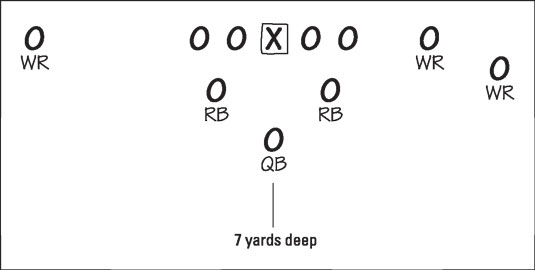In football terminology, formation describes how the players on offense line up before the ball is snapped. As football has evolved, so have the formations. The shotgun passing formation was devised by San Francisco 49ers head coach Red Hickey in 1960.
Hickey feared the Baltimore Colts' great pass rush, so he had his quarterback, John Brodie, line up 7 yards behind the line of scrimmage (see the figure). Hickey figured that Brodie would have more time to see his receivers and could release the ball before the defensive rush reached him. The strategy worked, and the 49ers upset the mighty Colts.

Offenses use the shotgun when they have poor pass blocking or when they're facing excellent pass rushers. Teams also use the shotgun when they want to pass on every down, usually when they're behind.
However, many offenses use the shotgun simply because the quarterback and the coach like to use it. Other teams use the shotgun only when they're in obvious passing situations — such as on third down when they need 4 or more yards for a first down, or anytime they need more than 10 yards for a first down.
Despite its versatility, the shotgun formation has a couple downsides:
The center must be able to make an accurate, chest-high, 7-yard snap to the quarterback.
You can't fool the defensive players; they know you're probably throwing the ball, and the pass rushers won't hesitate to sprint for your quarterback in hopes of a sack.
Teams need a quick-thinking quarterback who can set his feet quickly in order to use the shotgun formation effectively.

